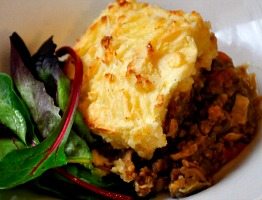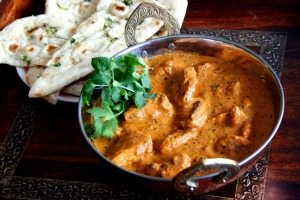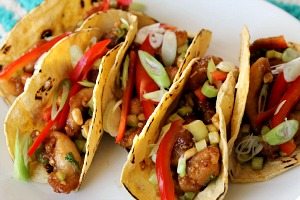Not all foodies are enamoured with fusion food. It’s a hard task to master.
Fusion food is the union of culinary traditions from two or more countries.
It takes the stand-point that any ingredient, from anywhere in the world has the potential to be cooked and eaten together.
The outcome? New and exciting taste combinations that cross political and geographical barriers.
This fusion phenomenon occurs in culturally diverse places; places with high levels of migration. Essentially, fusion food stands for the acceptance and assimilation of one culture into another.
A single country can become a melting pot for many cultural tastes and practices. Food becomes a political statement. A marker in time of one culture’s approval of another. Examples of fusion food include Tex-Mex, Pan-Asian and most notably any Indo-European union.

Dried produce can be transported easily without spoiling in transit. Spices such as ground ginger have been absorbed into worldwide cooking for generations.
We all strive for variety, and fusion food encapsulates this desire. Fusion food screams travel and worldliness. The affordability of long-haul travel to distant places like Thailand or Brazil has meant that we can titillate our own taste buds. We become the explorer. We bring home our own ideas and recreate them with our own take on a dish.
Fusion food can be adopted in one of two ways. Produce from one nation can be used in the everyday cooking of another. For example the wholesome potato’s roots actually lie in Peru. Or, equally, a national dish can be absorbed and tweaked by another nation. One cue that a cuisine has successfully infiltrated a society is readymade supermarket versions. Take for example curry sauce, lasagne or even sushi.

There truly is no greater accolade. Its acceptance has been further concreted in Britain’s curry capitals. Birmingham’s balti triangle draws in throngs of Brits to sample what they believe to be authentic South-Asian delicacies.
So why is Indian food so successful in Britain? Surely the exotic spices of India are a far cry from the bland traditionalist dishes of Britain. One reason – curry has been modified for the British palate. Fusion food really only works if foreign flavours are made more palatable for another culture’s taste.
Chicken tikka masala was voted Britain’s most popular dish. Ahmed Aslam Ali, owner of Glasgow’s Shish Mahal, claims: “Chicken tikka masala was invented in this restaurant.”

Another example of successful cultural fusion is Indo-Chinese cuisine. Its origins lie with a small immigrant Chinese community from Calcutta.
The modification of Chinese cooking techniques and flavours to suit the Indian palate has meant that Indo-Chinese is highly sought-after by Indian communities.
Again, what makes this cuisine so popular is that it’s tailored to the right audience. Taking one cuisine – Chinese – and adding familiarity to it. In this case by adding chilli, garlic, cumin and coriander.
Leo Liao, owner of Szechuan Garden says:
“Indian Chinese cuisine involves a different cooking style. We use a lot of red and green chillies, coriander, peppercorn and garam masala. The end result has got to be spicier dish with a heavy flavour.”
However, not all foodies are enamoured with fusion food. It’s a hard task to master. One chef explained that: “You need to understand food. The ability to use whatever ingredient doesn’t mean you should.”
Kung Pao Chicken Tacos

Ingredients:
6 skinless, boneless chicken thighs, cut into bite-sized pieces
3 tablespoons soy sauce, divided
30g plus 1 ½ teaspoons cornstarch or flour, divided
¼ teaspoon salt
2 tablespoons sunflower oil, divided
1 ½ tablespoons honey
1 tablespoon dark sesame oil
2 teaspoons rice vinegar
1 teaspoon ground fresh chilli paste
1 large garlic clove, minced
3 tablespoons coarsely chopped dry-roasted peanuts
170g diagonally sliced celery (about 2 stalks)
8 corn tortillas
50g sliced green onions
½ medium red bell pepper, thinly sliced
4 lime wedges
Preparation method:
- Add the chicken to a large zip-top sandwich bag. Add 1 tablespoon soy sauce to the bag and seal. Marinate at room temperature for 30 minutes.
- Remove the chicken from the bag and discard the marinade.
- Put 30g cornstarch on a plate.
- Add the chicken to the cornstarch and coat. Shake off any excess cornstarch.
- Heat a large frying pan over a medium to high heat and add 1 tablespoon of sunflower oil to the pan.
- Add half of the chicken to the pan and fry for 6 minutes, until browned.
- Remove chicken from the pan and set aside. Repeat with the remaining 1 tablespoon sunflower oil and chicken. Cook until brown.
- Combine the remaining 1½ teaspoons cornstarch, remaining 2 tablespoons soy sauce, honey, sesame oil, rice vinegar, and fresh chilli paste in a microwave safe bowl. Stir with a whisk until smooth.
- Heat sauce for 1½ minutes, or until slightly thick, stirring every 30 seconds. Stir in the garlic.
- Combine the chicken, peanuts and celery in the soy sauce mixture and toss to coat.
- Warm the tortillas in the microwave for 30 seconds.
- Place 2 tortillas on each of 4 plates; divide chicken mixture evenly among tortillas. Top each taco with green onions and bell pepper strips; serve with lime wedges.
Some critics say fusion food strikes them with fear. When done well, it breaks the mould. When done badly, the consequences are repulsive. Critics have coined fusion food as Con-fusion food.
They suggest we leave it to the professionals or just leave it altogether. But why would we want to consign ourselves to that? We’re all aware that not every flavour is going to work with another, but we want the chance to at least try new flavours.
So remember, the next time you’re eating wasabi mash potatoes, Mexican lasagne or Kung Pao chicken tacos, fusion is the future. The world will never return to its former isolation. Travel, migration and globalisation have been key in creating this universal change.
We can only become more and more intermingled and food will map our progress. Yes, the sceptics amongst us may claim it’s all con-fusion food, but this is the future. Today, no culture or nation can be taken in isolation. We can’t move backwards. But then again, why would we want to?





























































